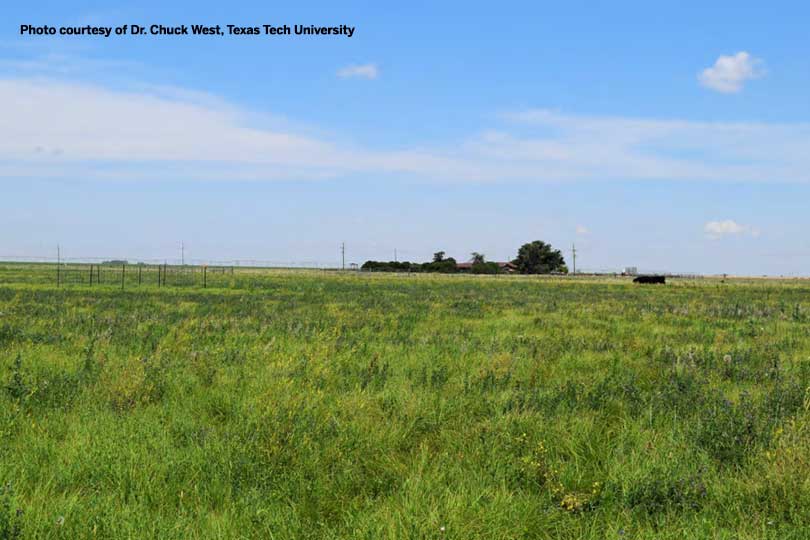By Jessica Domel
Multimedia Reporter
New research out of Texas Tech University reveals there may be a way for cattlemen and women on the Texas High Plains to help their cattle gain more from grazing while using less water.
The research is led by Dr. Chuck West, the university’s director of the College of Agricultural Science and Natural Resources Water Center.
“The goal is to test the grazing management of different forages to see how we can increase the livestock productivity while using grazing,” West said in an interview with the Texas Farm Bureau Radio Network.
West looked at a variety of Old World Bluestem called WW-B Dahl, because it is effective under low irrigation—nine inches of water or less per year—and can survive without it.
“It matures late in the summer, so instead of shooting up stems and seed heads early in the summer, like in June, it would delay that seed head until late July or early August,” he said.
That allows the forage to stay leafy longer in the summer and maintain its quality. It also helps build organic matter in the soil.
As part of the research, West also interseeded alfalfa, a legume, into the WW-B Dahl.
“As a legume, it has two big advantages,” West said. “One is that it is a crop that has bacteria that will grow in the roots, which will take nitrogen from the air and make that nitrogen available for the plant to produce protein.”
The alfalfa and WW-B Dahl mixture doesn’t need nitrogen fertilizer, which saves money.
The protein then helps the plant produce leaves and grow more forage, which is higher in protein than the grasses growing with it.
“Protein is an important limiting nutrient for cattle grazing on grass,” West said. “In grass, we have to boost the protein level by fertilizing with nitrogen fertilizer, which costs money. Whereas the alfalfa, we just increase it in the mixture, and that provides a protein without having to add nitrogen fertilizer.”
To do that, West would like to see at least 25 to 40 percent of the stand in alfalfa.
“That’s enough in there to really boost that protein and to get the energy values up. Cattle do well on it,” he said.
West’s research is on stocker steers starting at around 450-500 pounds.
They’re on the pastures for about four months.
“During that time, they’ll gain over two pounds a day,” West said. “In fact, sometimes we even get three pounds a day. They’ll come off of that around 750-800 pounds.”
West said it’s an option for producers who have reduced irrigation capacity and have to cut back on their irrigated row crops.
“That is a type of water use efficiency. We are stating or calculating how much water it took in terms of rain, in terms of irrigation water, to produce a pound of live weight gain,” he said.
The research also looked at a small acreage of a nearly-pure stand of alfalfa growing with tall wheat grass.
“It was essentially alfalfa. We would rotate cattle in there to graze for fairly short periods—let’s say two to three days—and then we would move them back out onto a grass pasture where there was some alfalfa or they moved to native grass,” West said.
West’s research focused on the Texas High Plains, but that doesn’t mean it couldn’t work in other parts of the state—if the soil is right.
“Up in the High Plains, we’re fortunate in that we have a soil that allows a pretty deep root penetration, and we can get roots going down three, four or five feet,” West said. “Alfalfa needs that to go down and explore for water.”
The High Plains has a fairly high soil pH that’s around seven to eight.
“The soil conditions really have to be good for alfalfa in order to make this work,” West said.
A presentation on West’s research is available at https://www.depts.ttu.edu/tawc/events/west.pdf.

